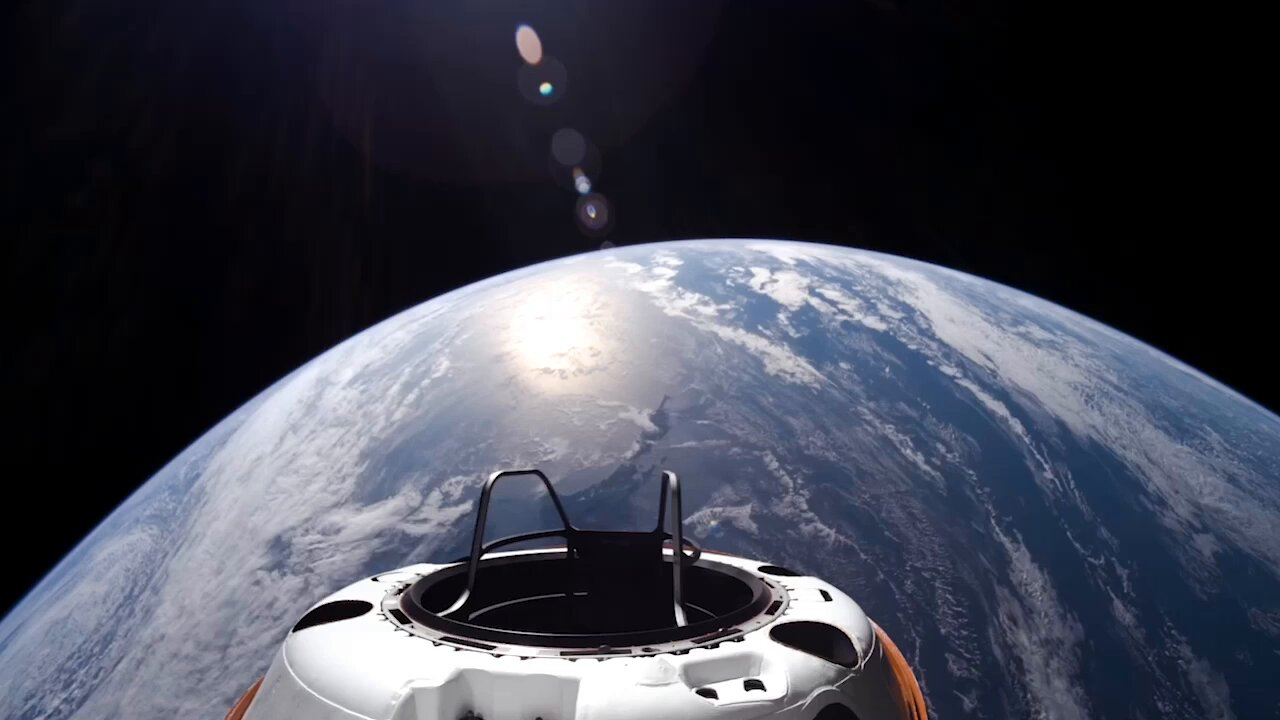
By Josh Dinner
Polaris Dawn has risen
The four-person Polaris Dawn mission launched early this morning (Sept. 10), with the goal of making some spaceflight history.
Polaris Dawn, which aims to conduct the first-ever private spacewalk, lifted off atop a SpaceX Falcon 9 rocket today at 5:23 a.m. EDT (0923 GMT) from historic Launch Complex-39A at NASA’s Kennedy Space Center (KSC). Pad 39A also hosted most of NASA’s Apollo moon launches, which were the last crewed missions to fly as far as the Polaris Dawn astronauts will travel.
Roaring off the launch pad, the rocket’s nine Merlin engines cast a blisteringly bright light on the still waters around KSC, climbing the sky as the fire’s glow reflected off the low, early morning clouds to disperse a dim yellow hue for miles around the space center, until becoming another shimmering point among the stars.
The launch was originally supposed to occur on Aug. 26, but SpaceX stood down from that attempt to perform more preflight checks. A try the following day was nixed after the mission team detected a helium leak in the equipment supporting the Falcon 9. The liftoff was then delayed multiple times by bad weather, before Mother Nature finally relented today.
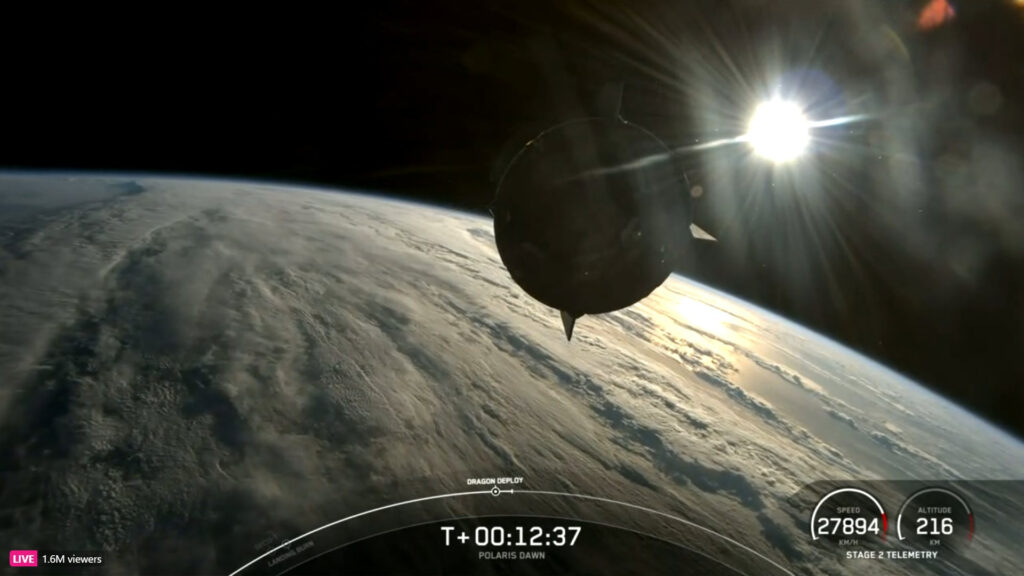
About two minutes and 40 seconds into the launch, the Falcon 9’s main engines cut off, and the booster separated from the second stage as planned. The booster then performed a series of burns to align its return trajectory with the SpaceX autonomous droneship Just Read the Instructions, which was stationed in the Atlantic Ocean. Approximately 9.5 minutes after liftoff, the rocket touched down on the barge off Florida’s eastern coast.
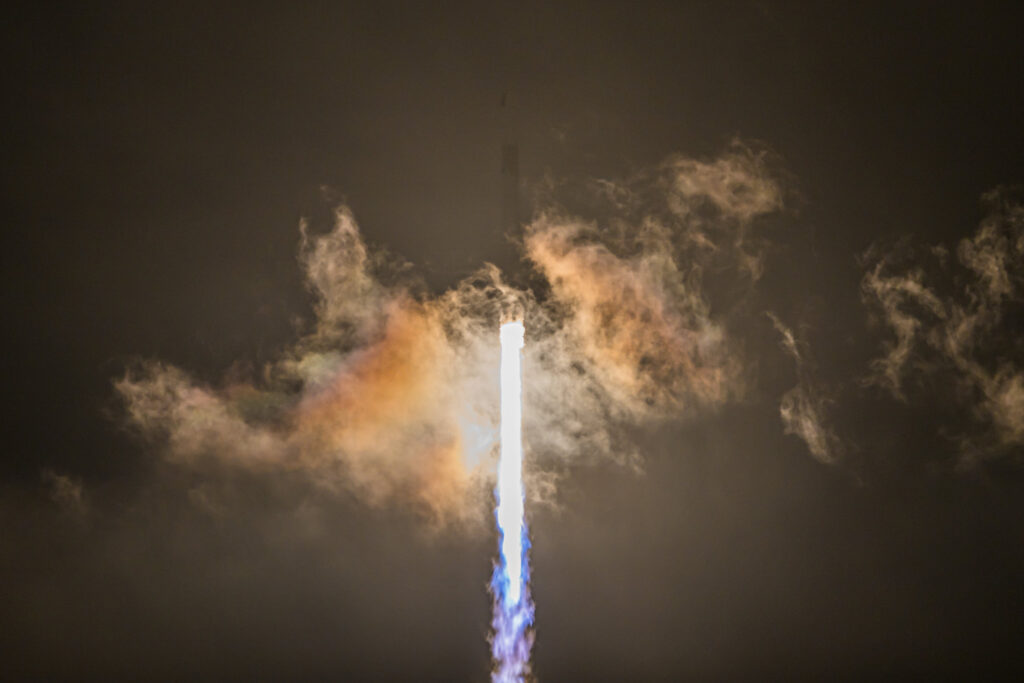
Polaris Dawn’s Crew Dragon spacecraft separated from the Falcon 9’s upper stage a little over 12 minutes after launch.
“We wouldn’t be on this journey without all 14,000 of you back home and everyone else cheering us on,” billionaire entrepreneur Jared Isaacman, who commands and funds Polaris Dawn, told SpaceX mission control shortly after Crew Dragon deployed into orbit. “We appreciate it. We’re gonna get to work now.”
The capsule settled into an initial elliptical orbit with a maximum altitude (apogee) of about 745 miles (1,200 kilometers), with the minimum altitude (perigee) holding at about 118 miles (190 km). After a few orbits, Crew Dragon will raise its apogee to about 870 miles (1,400 km) — higher than any human has flown since the final Apollo mission in 1972.
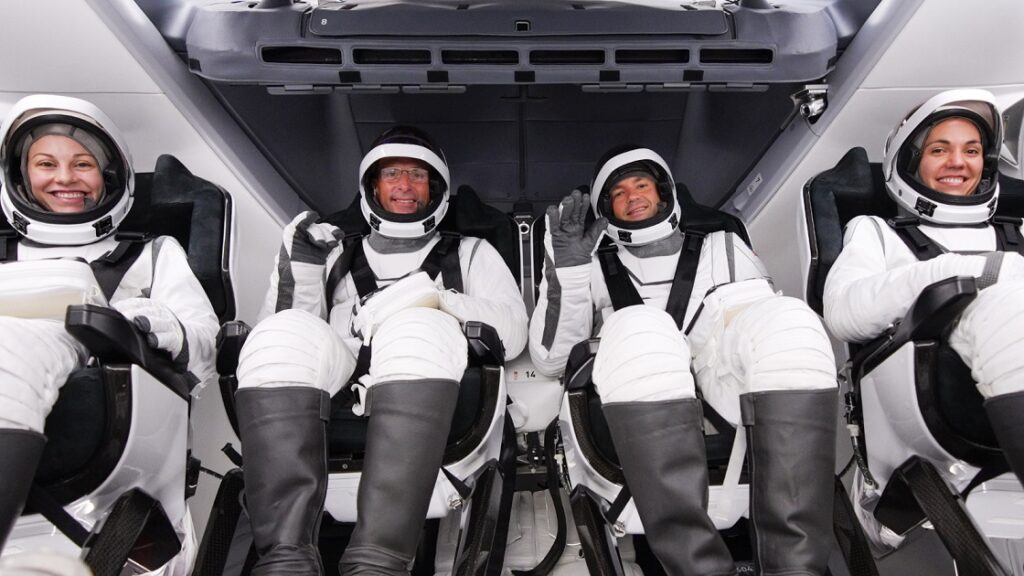
Isaacman has been to space once before. He also funded and commanded SpaceX’s Inspiration4 mission in September 2021, which raised $250 million for St. Jude Children’s Research Hospital in Memphis, Tennessee. Isaacman hopes this mission can build on that momentum.
He is joined on Polaris Dawn by the first two SpaceX employees to launch to orbit, mission specialists Sarah Gillis and Anna Menon, as well as retired U.S. Air Force Lt. Col. Scott “Kidd” Poteet, who serves as mission pilot. The quartet will spend the next five days in space, completing a few dozen experiments in the novel space environment that the mission is exploring.
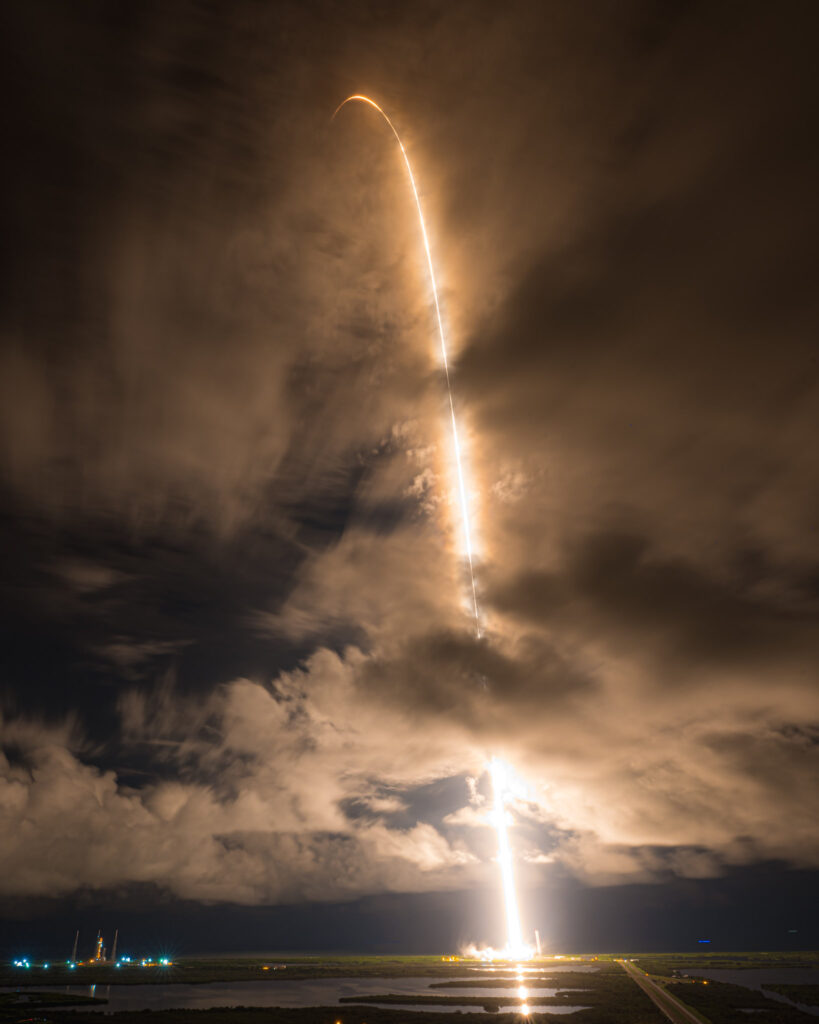
After Polaris Dawn’s second day in space, Dragon will lower its apogee to about 435 miles (700 km), where it will remain until its deorbit burn and return to Earth. At this altitude, the Polaris Dawn crew will conduct the most critical part of its mission: history’s first commercial spacewalk.
The EVA (extravehicular activity) will take place on the third day of the mission. A chief goal of the operation is to test out SpaceX’s new EVA spacesuit, which is visually similar to the company’s familiar black-and-white IVA (intravehicular activity) suit, which is worn only inside the spacecraft.
Crew Dragon doesn’t have an airlock, so the capsule’s entire interior will be exposed to the vacuum of space during the EVA. All four Polaris Dawn crewmembers will therefore suit up during the spacewalk, though only Isaacman and Gillis will venture outside the spacecraft.
The duo will take turns exiting Crew Dragon to test the functionality and maneuverability of their suits. In total, the Polaris Dawn EVA will last about two hours from the start of Crew Dragon’s depressurization until the hatch is closed and the cabin repressurized.
The crew will prep for the historic spacewalk with a two-day “pre-breathe” campaign, inhaling special gas mixtures to remove nitrogen from their bloodstreams and thereby lower the risk of “the bends,” or decompression sickness.
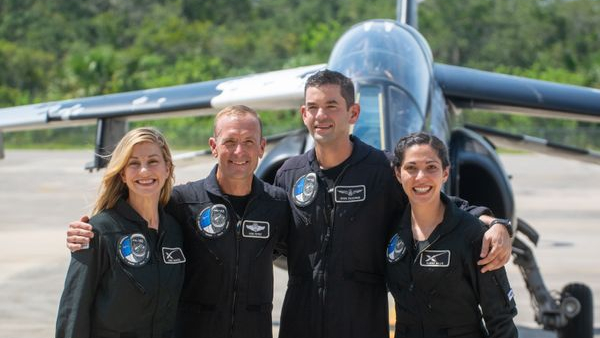
he mission’s fourth day includes a Starlink demonstration; the Polaris Dawn crew has teased an exciting surprise message they intend to transmit down to Earth via SpaceX’s megaconstellation of internet satellites.
Day five of Polaris Dawn will be spent preparing for the return journey home, provided all the other mission goals have been achieved by this point. (The crewmembers will also conduct about 40 science experiments during the mission.)
Polaris Dawn’s Dragon is expected to splash down six days after liftoff, performing a final series of deorbit burns on a return trajectory for terra firma. If everything goes according to plan, the Polaris Dawn crew will parachute into the ocean in one of a handful of potential landing zones off the coast of Florida, where a recovery ship will retrieve the spacecraft and crew.
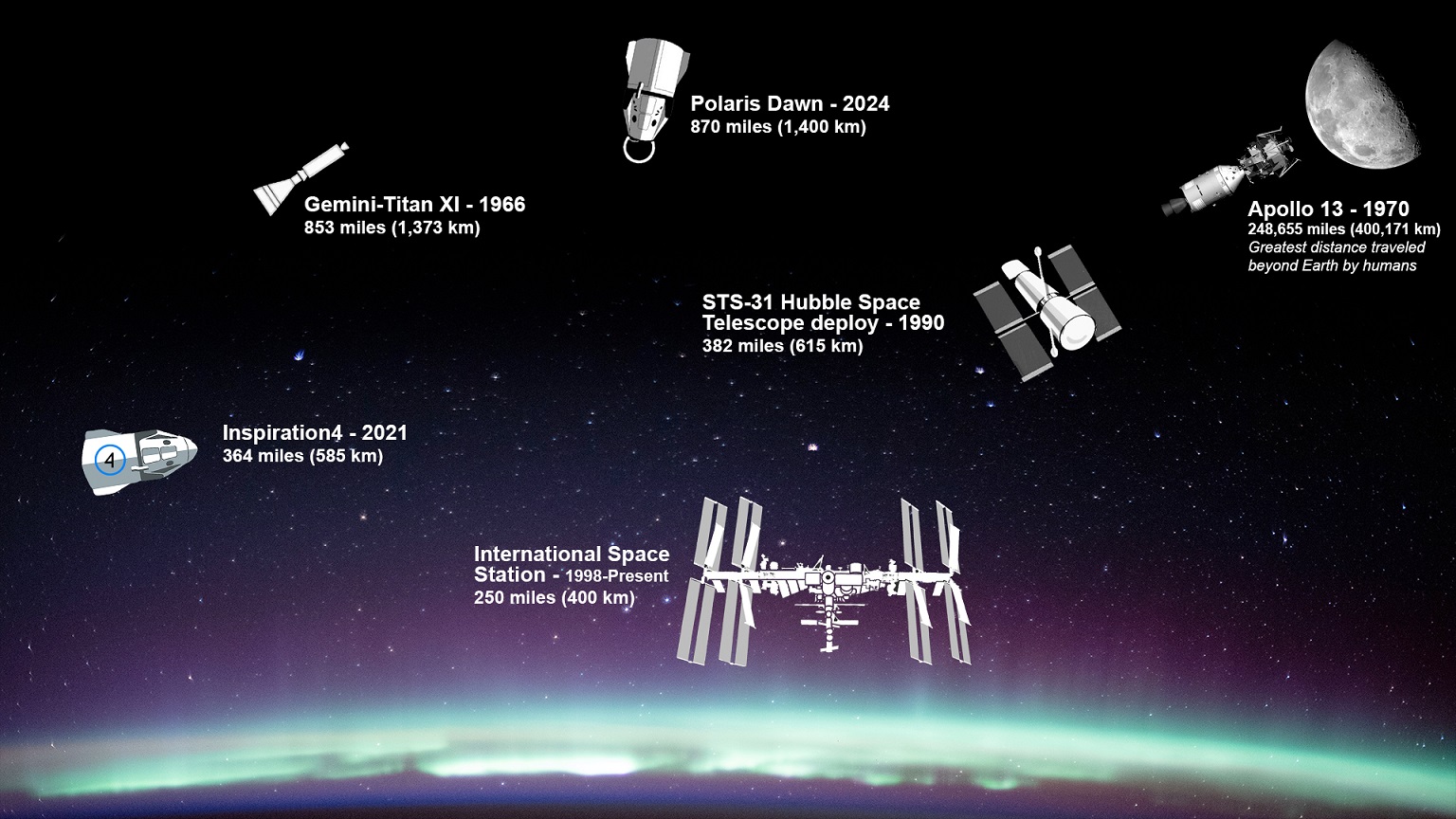
Source: Space.com










Cancel anytime


Using our website
You may use the The Middle Land website subject to the Terms and Conditions set out on this page. Visit this page regularly to check the latest Terms and Conditions. Access and use of this site constitutes your acceptance of the Terms and Conditions in-force at the time of use.
Intellectual property
Names, images and logos displayed on this site that identify The Middle Land are the intellectual property of New San Cai Inc. Copying any of this material is not permitted without prior written approval from the owner of the relevant intellectual property rights.
Requests for such approval should be directed to the competition committee.
Please provide details of your intended use of the relevant material and include your contact details including name, address, telephone number, fax number and email.
Linking policy
You do not have to ask permission to link directly to pages hosted on this website. However, we do not permit our pages to be loaded directly into frames on your website. Our pages must load into the user’s entire window.
The Middle Land is not responsible for the contents or reliability of any site to which it is hyperlinked and does not necessarily endorse the views expressed within them. Linking to or from this site should not be taken as endorsement of any kind. We cannot guarantee that these links will work all the time and have no control over the availability of the linked pages.
Submissions
All information, data, text, graphics or any other materials whatsoever uploaded or transmitted by you is your sole responsibility. This means that you are entirely responsible for all content you upload, post, email or otherwise transmit to the The Middle Land website.
Virus protection
We make every effort to check and test material at all stages of production. It is always recommended to run an anti-virus program on all material downloaded from the Internet. We cannot accept any responsibility for any loss, disruption or damage to your data or computer system, which may occur while using material derived from this website.
Disclaimer
The website is provided ‘as is’, without any representation or endorsement made, and without warranty of any kind whether express or implied.
Your use of any information or materials on this website is entirely at your own risk, for which we shall not be liable. It is your responsibility to ensure any products, services or information available through this website meet your specific requirements.
We do not warrant the operation of this site will be uninterrupted or error free, that defects will be corrected, or that this site or the server that makes it available are free of viruses or represent the full functionality, accuracy and reliability of the materials. In no event will we be liable for any loss or damage including, without limitation, loss of profits, indirect or consequential loss or damage, or any loss or damages whatsoever arising from the use, or loss of data, arising out of – or in connection with – the use of this website.
Last Updated: September 11, 2024
New San Cai Inc. (hereinafter “The Middle Land,” “we,” “us,” or “our”) owns and operates www.themiddleland.com, its affiliated websites and applications (our “Sites”), and provides related products, services, newsletters, and other offerings (together with the Sites, our “Services”) to art lovers and visitors around the world.
This Privacy Policy (the “Policy”) is intended to provide you with information on how we collect, use, and share your personal data. We process personal data from visitors of our Sites, users of our Services, readers or bloggers (collectively, “you” or “your”). Personal data is any information about you. This Policy also describes your choices regarding use, access, and correction of your personal information.
If after reading this Policy you have additional questions or would like further information, please email at middleland@protonmail.com.
PERSONAL DATA WE COLLECT AND HOW WE USE IT
We collect and process personal data only for lawful reasons, such as our legitimate business interests, your consent, or to fulfill our legal or contractual obligations.
Information You Provide to Us
Most of the information Join Talents collects is provided by you voluntarily while using our Services. We do not request highly sensitive data, such as health or medical information, racial or ethnic origin, political opinions, religious or philosophical beliefs, trade union membership, etc. and we ask that you refrain from sending us any such information.
Here are the types of personal data that you voluntarily provide to us:
As a registered users or customers, you may ask us to review or retrieve emails sent to your business. We will access these emails to provide these services for you.
We use the personal data you provide to us for the following business purposes:
Information Obtained from Third-Party Sources
We collect and publish biographical and other information about users, which we use to promote the articles and our bloggers who use our sites. If you provide personal information about others, or if others give us your information, we will only use that information for the specific reason for which it was provided.
Information We Collect by Automated Means
Log Files
The site uses your IP address to help diagnose server problems, and to administer our website. We use your IP addresses to analyze trends and gather broad demographic information for aggregate use.
Every time you access our Site, some data is temporarily stored and processed in a log file, such as your IP addresses, the browser types, the operating systems, the recalled page, or the date and time of the recall. This data is only evaluated for statistical purposes, such as to help us diagnose problems with our servers, to administer our sites, or to improve our Services.
Do Not Track
Your browser or device may include “Do Not Track” functionality. Our information collection and disclosure practices, and the choices that we provide to customers, will continue to operate as described in this Privacy Policy, whether or not a “Do Not Track” signal is received.
HOW WE SHARE YOUR INFORMATION
We may share your personal data with third parties only in the ways that are described in this Privacy Policy. We do not sell, rent, or lease your personal data to third parties, and We does not transfer your personal data to third parties for their direct marketing purposes.
We may share your personal data with third parties as follows:
There may be other instances where we share your personal data with third parties based on your consent.
HOW WE STORE AND SECURE YOUR INFORMATION
We retain your information for as long as your account is active or as needed to provide you Services. If you wish to cancel your account, please contact us middleland@protonmail.com. We will retain and use your personal data as necessary to comply with legal obligations, resolve disputes, and enforce our agreements.
All you and our data are stored in the server in the United States, we do not sales or transfer your personal data to the third party. All information you provide is stored on a secure server, and we generally accepted industry standards to protect the personal data we process both during transmission and once received.
YOUR RIGHTS/OPT OUT
You may correct, update, amend, delete/remove, or deactivate your account and personal data by making the change on your Blog on www.themiddleland.com or by emailing middleland@protonmail.com. We will respond to your request within a reasonable timeframe.
You may choose to stop receiving Join Talents newsletters or marketing emails at any time by following the unsubscribe instructions included in those communications, or you can email us at middleland@protonmail.com
LINKS TO OTHER WEBSITES
The Middle Land include links to other websites whose privacy practices may differ from that of ours. If you submit personal data to any of those sites, your information is governed by their privacy statements. We encourage you to carefully read the Privacy Policy of any website you visit.
NOTE TO PARENTS OR GUARDIANS
Our Services are not intended for use by children, and we do not knowingly or intentionally solicit data from or market to children under the age of 18. We reserve the right to delete the child’s information and the child’s registration on the Sites.
PRIVACY POLICY CHANGES
We may update this Privacy Policy to reflect changes to our personal data processing practices. If any material changes are made, we will notify you on the Sites prior to the change becoming effective. You are encouraged to periodically review this Policy.
HOW TO CONTACT US
If you have any questions about our Privacy Policy, please email middleland@protonmail.com
The Michelin brothers created the guide, which included information like maps, car mechanics listings, hotels and petrol stations across France to spur demand.
The guide began to award stars to fine dining restaurants in 1926.
At first, they offered just one star, the concept was expanded in 1931 to include one, two and three stars. One star establishments represent a “very good restaurant in its category”. Two honour “excellent cooking, worth a detour” and three reward “exceptional cuisine, worth a
Thank you for your participation,
please Log in or Sign up to Vote

123Sign in to your account
Trump Revives Push to Make Federal Architecture ‘Beautiful Again’ with Classical Mandate